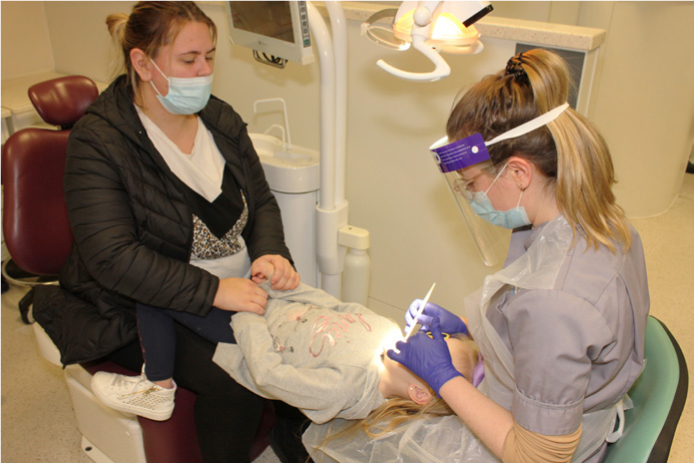CPD/Clinical Relevance: The lap-to-lap technique is very useful and can greatly help all dentists in conducting dental examinations in young and uncooperative patients, in both primary and secondary care settings.
It is advised that all young children are brought to see a dentist as soon as their first teeth come through and ideally, before the age of one year.1 Early dental appointments are essential to monitor the oral health of the primary dentition, to instigate good oral hygiene habits and to familiarize the child with the dental setting, which is believed to reduce future anxiety.1,2,3 Unfortunately, only one in 10 children under the age of 2 years has had their first dental check up by their first birthday.4 Dental anxiety and phobia are common in paediatric patients, affecting 51% of pre-school children.5 Performing dental examinations on these young, and potentially anxious and uncooperative, children can be daunting for clinicians, particularly for those with limited experience in paediatric dentistry.
It is imperative that dentists are familiar with the necessary behaviour management techniques and equipment needed to effectively examine these young patients. The main aim is to complete a successful examination while avoiding a negative experience, and fostering a positive relationship with the dental team. Successful management of child patients is a team effort, involving dental professionals, parents and the patient.6
Basic behaviour management strategies can be divided into two groups: verbal and non-verbal.5 The main objectives of effective verbal behaviour adjustment are to gain patient compliance and attention, to establish effective child–adult roles, and to avert negative behaviour. The non-verbal approach aims to solidify and further guide the desired behaviour through appropriate facial expressions and contacts.7
The lap-to-lap examination approach is considered to be one of the non-verbal techniques that can help dental professionals to effectively and safely examine a young patient’s oral cavity, while they get to remain comfortably reclined on their parent’s lap.
This approach can significantly reduce a child’s anxiety and helps to establish trust between the child and the paediatric professional. This technique can be used for children aged 6 months to 3 years, or up to age 5 for children with special needs.8
With this particular technique, a parent sits in a chair, dental or regular, with a child sitting on his/her lap facing towards the parent. The child’s legs are around the parent’s waist. This is crucial because this positioning can assist in stabilizing the patient. The dentist sits on another chair, which is placed in front of the dental chair (Figure 1). The patient should also wear protective eyewear if they are compliant.
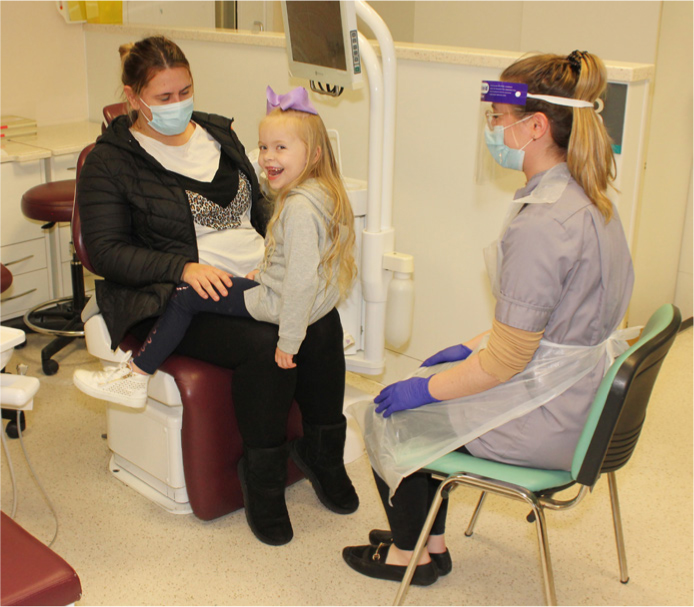
The clinician and caregiver should work together to transition the child smoothly to the lap-to-lap position. It is imperative to explain what will happen, through ‘tell, show, do’ prior to starting and to anticipate that the child may cry, which is developmentally normal for their age. The caregiver continues to support the hands of the child and their legs are wrapped around the caregiver’s waist, the child then lays their head on the lap of the clinician, who can then gently position the child’s head to enable examination, as demonstrated on the photographs (Figure 2).
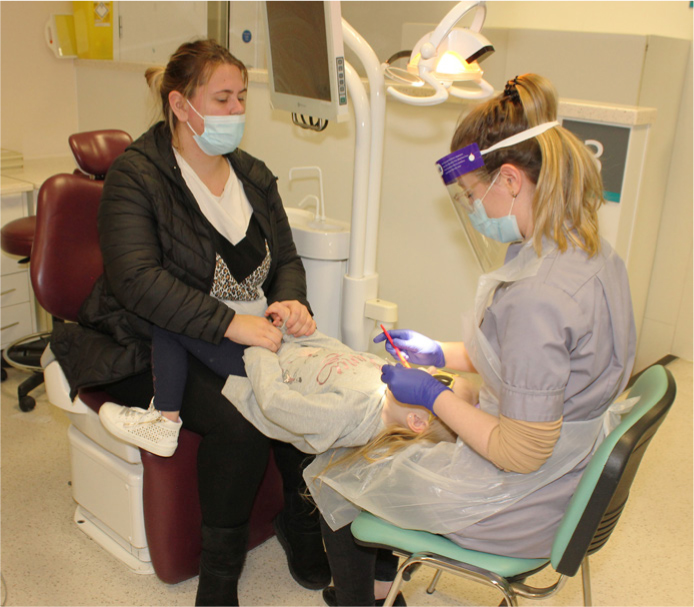
This allows the child to maintain eye contact with their parent and the parent can stabilize their arms. It is important to warn the parent, that the child may cry and that if they do, this can provide an opportunity for the clinician to quickly examine the patient’s dentition. Additionally, we recommend the use of a plastic mirror in cases where the patient can accidently bite down on it. A sample kit used commonly for dental examination on child patients is illustrated in Figure 3.
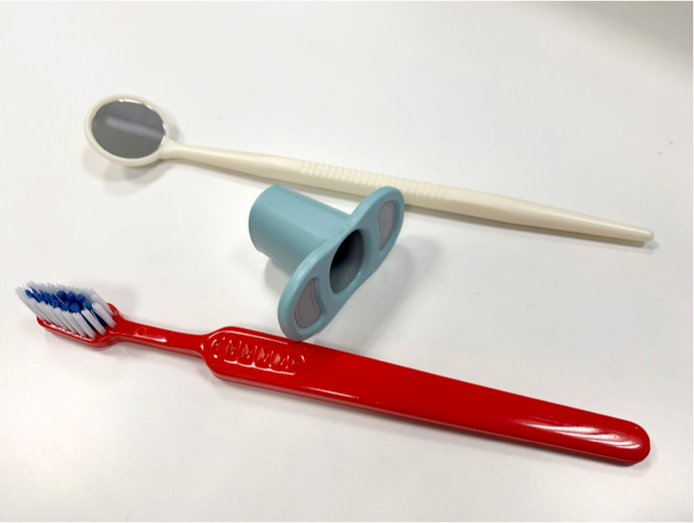
For patients who struggle to keep their mouth open during a dental check-up, brushing or other procedures, dentists may wear the Bedi Shield mouth prop on their finger to protect them (Figure 4). With the mouth prop in situ, a clinician can chart upper and lower teeth on one side, then, without removing the prop gently slide it to the other side to allow charting of upper and lower teeth on the opposite side. A toothbrush can also be used as a mouth prop because young children are more likely to open their mouth for a toothbrush than for a dental mirror.
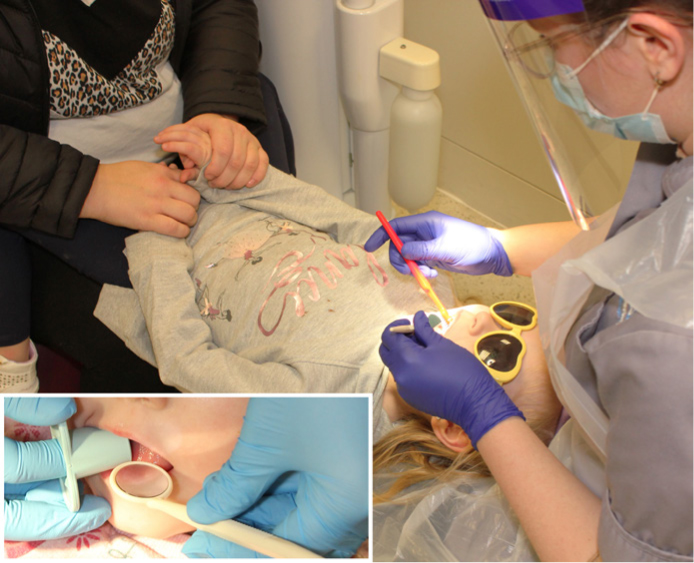
It is also important to note that the lap-to-lap position can also be useful for the delivery of basic preventative treatments, such as fluoride varnish and silver diamine fluoride application, for children who cannot tolerate sitting alone in the dental chair.
Overall, these techniques not only greatly help in reducing fear in child patients during dental examinations, but they can also build up and reinforce the essential trust between the patient and dental professionals, thereby helping patients become more comfortable with dental treatments. As a behaviour-modification approach, the lap-to-lap technique can additionally prevent the development of dental phobia and prepare paediatric patients to accept more invasive procedures in the future without negatively affecting their view of dental treatments (Figure 5).
